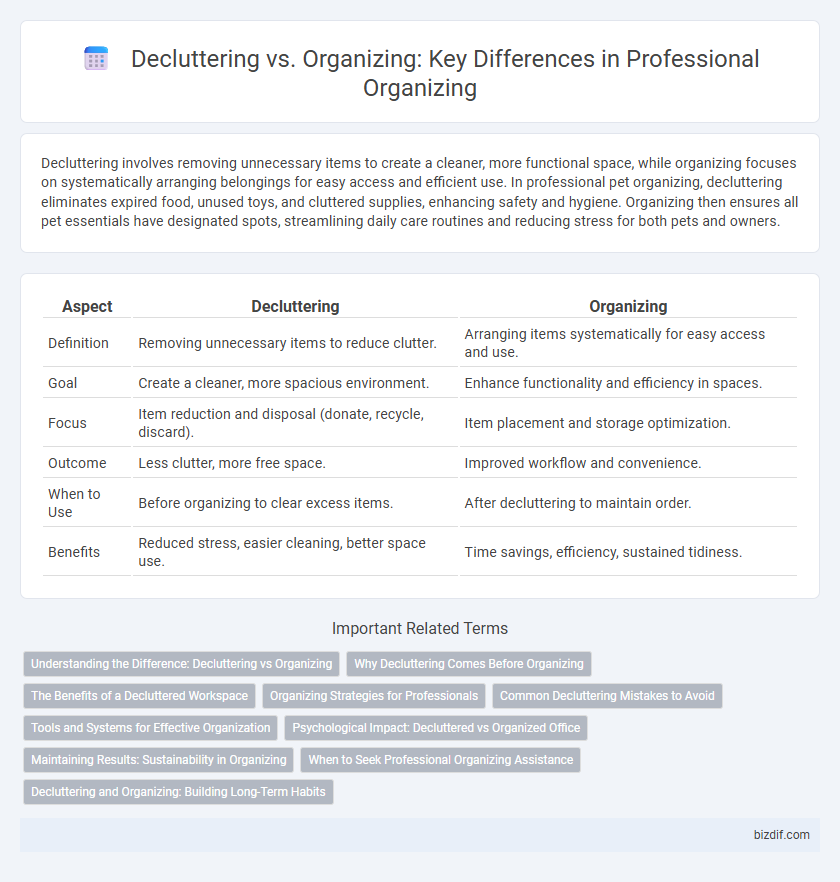Decluttering involves removing unnecessary items to create a cleaner, more functional space, while organizing focuses on systematically arranging belongings for easy access and efficient use. In professional pet organizing, decluttering eliminates expired food, unused toys, and cluttered supplies, enhancing safety and hygiene. Organizing then ensures all pet essentials have designated spots, streamlining daily care routines and reducing stress for both pets and owners.
Table of Comparison
| Aspect | Decluttering | Organizing |
|---|---|---|
| Definition | Removing unnecessary items to reduce clutter. | Arranging items systematically for easy access and use. |
| Goal | Create a cleaner, more spacious environment. | Enhance functionality and efficiency in spaces. |
| Focus | Item reduction and disposal (donate, recycle, discard). | Item placement and storage optimization. |
| Outcome | Less clutter, more free space. | Improved workflow and convenience. |
| When to Use | Before organizing to clear excess items. | After decluttering to maintain order. |
| Benefits | Reduced stress, easier cleaning, better space use. | Time savings, efficiency, sustained tidiness. |
Understanding the Difference: Decluttering vs Organizing
Decluttering involves removing unnecessary items to create a cleaner, more functional space, while organizing focuses on arranging remaining belongings for optimal use and accessibility. Effective professional organizing combines both processes to enhance efficiency and maintain order. Understanding this distinction helps tailor strategies that address both excess and spatial arrangement for lasting results.
Why Decluttering Comes Before Organizing
Decluttering removes unnecessary items, creating a clear foundation essential for effective organizing. Without decluttering, organizing systems become overwhelmed and inefficient, making it difficult to maintain order. Prioritizing decluttering ensures spaces are functional and maximizes storage solutions' potential.
The Benefits of a Decluttered Workspace
A decluttered workspace enhances productivity by reducing distractions and improving focus, allowing professionals to complete tasks more efficiently. It promotes a sense of calm and reduces stress, creating an environment conducive to creativity and decision-making. Clear surfaces and well-organized materials facilitate easier access to essentials, saving time and boosting overall work performance.
Organizing Strategies for Professionals
Professional organizing strategies emphasize categorizing items by function and frequency of use to maximize space efficiency. Effective decluttering removes unnecessary possessions, while organizing involves creating systematic storage solutions tailored to client lifestyles. Implementing color-coded labels, modular containers, and designated zones enhances accessibility and maintains long-term order.
Common Decluttering Mistakes to Avoid
Common decluttering mistakes to avoid include keeping items out of guilt or sentimentality, which hinders space optimization and increases clutter retention. Failing to categorize belongings before deciding what to discard can lead to unnecessary discarding or misplacement of valuable items. Overlooking the importance of creating a maintenance system often results in recurring clutter, disrupting long-term organizing success.
Tools and Systems for Effective Organization
Effective organization relies on specialized tools like labeled storage containers, adjustable shelving, and digital inventory apps to streamline space utilization and maintain order. Implementing systems such as color-coding, categorization, and time-based purging schedules enhances accessibility and prevents clutter buildup. Prioritizing these tools and systems transforms chaotic environments into functional, efficient spaces optimized for productivity.
Psychological Impact: Decluttered vs Organized Office
A decluttered office reduces stress and mental fatigue by removing unnecessary distractions, creating a visually calming environment that promotes focus. An organized office not only minimizes chaos but also enhances productivity through efficient space utilization and streamlined access to essential materials. Both decluttering and organizing contribute to improved cognitive function, but organizing provides a sustainable system that supports long-term psychological well-being.
Maintaining Results: Sustainability in Organizing
Maintaining results in professional organizing requires sustainable strategies that emphasize consistent habits over one-time decluttering. Organizing focuses on creating systems that prevent clutter from reaccumulating, promoting long-term order and efficiency. Sustainable organizing practices integrate personalized storage solutions and routine maintenance plans that support lasting organization.
When to Seek Professional Organizing Assistance
Recognizing when decluttering feels overwhelming or progress stalls signals the need for professional organizing assistance. Experts offer tailored strategies to efficiently sort and categorize belongings, transforming chaotic spaces into functional environments. Their specialized skills help maintain long-term organization, reducing stress and enhancing productivity.
Decluttering and Organizing: Building Long-Term Habits
Decluttering focuses on removing unnecessary items to create a more functional space, while organizing arranges remaining belongings for easy access and efficiency. Building long-term habits requires consistent decluttering sessions to prevent accumulation and adopting systematic organizing techniques, such as categorization and storage optimization. Professionals emphasize integrating these habits into daily routines to maintain order and reduce stress over time.
decluttering vs organizing Infographic

 bizdif.com
bizdif.com